
Features | Concerts
Colour Revolt
By Andre Perry | 21 October 2010
When Colour Revolt played the Blue Moose Tap House about a month ago, it was under very modest circumstances. The concert was upstairs in the small room usually reserved for local shows and there were only about 30 people in there; the bar had a quiet, tired air about it. It was a pit-stop—a necessary show on the band’s way back to the South, a chance to make some extra money, especially because it sounded like their whole tour had been less well-attended than planned, that even in the big cities the crowds had only been proportionally bigger.
All of this was a shame because the band was in top form that night. So what happens to a band like Colour Revolt in this world? What happens to a band that’s already been around for a comparatively long while, that spent time on both major and indie labels before arriving at current indie Dualtone? How can I pay attention to a band like this when it feels like I hear about seven or eight new ones each week?
Colour Revolt’s recent back-story is harrowing: the bulk of the band quit, leaving the principle singer-songwriters, Jesse Coppenbarger and Sean Kirkpatrick, to helm the project just weeks before recording their latest album, The Cradle. Somehow they culled together a new band, went into the studio, and produced, in my opinion, one of 2010’s very notable albums, but so far the record’s spent much of its time flying below the radar of critics and listeners, even garnering a deflating 4.4 from Pitchfork, a high-profile publication known for lathering Best Coast with a marketable Best New Music (however curious you find that fact).
It is in this set of circumstances—a band rising from the ashes, a record that’s had mum response, and a tour that hasn’t been a string of packed houses—that the latest incarnation of Colour Revolt assembled their debut at the Blue Moose in Iowa City. Their set was not only heart-on-its-sleeves astonishing, it was one of the most impressive shows to have hit Iowa City this fall.
The rest of the band set up around bandleaders Coppenbarger and Kirkpatrick, who both sing and play guitar. Their singing, alone, was arresting: through most of the songs they shared the vocals, pulling off long-form harmonies, Kirkpatrick’s voice offering the subtle counterpart to Coppenbarger’s upfront croon, but at choice points both were ready to take the lead. Reminiscent of the early promise of Texas rockers Midlake, their voices carried a certain weariness but were also quite capable of hitting high octaves with grace. Their band included a rhythm section and a keyboardist, who, while brought together for the album and tour, played with undeniable energy. They didn’t seem like sidemen, more like integral members of a solid group that had been at it for several years.
Songs weaved nicely between older cuts and newer tracks from The Cradle. The strength of their set was built on their ability to lilt over hushed moments—moments composed just of harmonies and tenderly plucked guitars—before crashing back into vicious, bombastic passages. The quiet/loud cue they cull from post-rock, but they add to it, strong melodies and deeply affecting arrangements easily on hand. Coming off as both a bit countrified and a bit not, they achieve the epic vastness of mid-era Radiohead with no shame in indulging angelic melodies and echoing, atmospheric guitars tones.
But the songs are aggressive, too: lots of start-stop dynamics and Constantines-esque grit. Their live rendition of “Reno” caught them at their best, its swirling, almost elliptical verse lulling the audience before it steadily built to a dramatic, deafening peak. Then there was the barreling, caustic “8 Years,” The Cradle’s lead-off track: a real burner on the record, it was even more effective in a live setting, the band gathering emphatically around Copperbarger’s anthemic chants of “One man’s limo is another man’s hearse.”
Though small in size, the crowd at the Blue Moose was faithfully locked in to the Colour Revolt’s set; even the bartender, who sees hundreds of bands a year, was fixated on them, obviously thinking less about serving drinks than absorbing the music. Even better, this intimate situation seemed to benefit them; utterly hypeless, the show wasn’t seen by one person who didn’t want to be there. As a result, what could have been a lackluster event turned into a shared experience in which everyone left fully convinced of the power of Colour Revolt’s music. And from this vantage point, it seems that a band like Colour Revolt can exist in a world in which new bands are unveiled weekly—we just hope they can keep their heads up and make another a few laps around the country before they stop believing 30 people isn’t enough.





